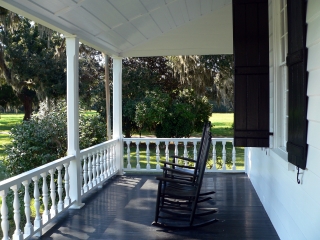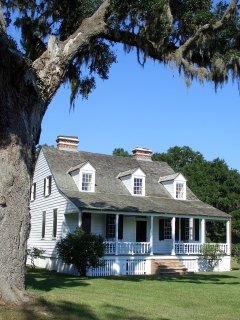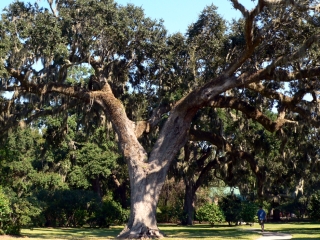NPS Website; Local Website
 WHAT IS IT?
WHAT IS IT?Historic plantation home that remembers the lives of both the property’s longtime owners, the Pinckney family, and the African slaves who made the land prosperous.
Charles Pinckney and his cousin Charles Cotesworth Pinckney were two of South Carolina’s four delegates to the 1787 Constitutional Convention. Historians affectionately call Charles Pinckney “Constitution Charlie” because of his purported prominent role in Philadelphia.
BEAUTY (4/10)
Do you think plantations homes are beautiful? We don’t. Pinckney never lived in the Site’s centerpiece, the modest white farmhouse cottage named the Snee Farm. In fact, he never even saw the building because it was built four years after his death! Pinckney’s primary home, a palatial townhouse in downtown Charlestown, still stands but is not a part of the National Park System. The Snee Farm land was just one of Pinckney’s seven plantations scattered throughout the lowcountry.
HISTORICAL INTEREST (5/10)
“Constitution Charlie” blah, blah, blah. He wrote a few clauses in, arguably, the most important document of the last 500 years. The Park also states that he “helped resolve problems that arose during the debates.” Pinckney’s importance at the Convention is subject of historical discussion; some think he wrote much of the document, some think he just talked a lot.
Pinckney later served as South Carolina’s governor and as its representative in both the U.S. Senate and House. He also was the Minister to Spain. Until 1795, Charles was a devoted Federalist. At that point, he switched his allegiances to the Democratic-Republican Party, some speculate because of spite for his cousin.
We found that cousin, Charles Cotesworth Pinckney, to be a lot more interesting. Here are a few tidbits about Cotesworth: his mother introduced indigo the Americas; he studied at Oxford and practiced law in London; he commanded troops in the Revolutionary War at Brandywine (Pa.), Germantown (Pa.), Savannah and Charleston; he was also prominent at the Constitutional Convention and was the leading defender of the document back in South Carolina.
In addition, Cotesworth served as a Supreme Court Justice, Secretary of War, Secretary of State and as Minister to France where he was embroiled in our young nation’s first international scandal, the XYZ Affair. As the Federalist candidate, he finished second in the U.S. Vice-Presidential Voting (1800) and U.S. Presidential Voting (1804 and 1808): He later helped found the University of South Carolina. Why isn’t this site dedicated to Cotesworth? What a life.
 CROWDS (6/10)
CROWDS (6/10)Just us.
EASE OF USE/ACCESS (3/5)
Charles Pinckney NHS is located on Long Point Drive in Mt. Pleasant, S.C. about a fifteen minute drive west of downtown Charleston. Long Point Drive can be accessed from the west via I-526 and from the east via U.S. 17 North. There is ample parking and good signage.
CONCESSIONS/BOOKSTORE (3/5)
How relevant can an historic figure be if there is only one book written about him in his own Historic Site’s bookstore: Charles Pinckney: Forgotten Founder, by Marty D. Matthews? And how forgotten can said figure be if he has a National Park Site in his honor?
The Bookstore gives center stage (atop a fireplace mantle) to cool looking colonial-era mugs, weatherglasses, tavern pipes, ink holders and tin lanterns. The serviceable selection of slavery-related books sits in the room’s isolated corner.
COSTS (4/5)
Entry is 100% free.
RANGER/GUIDE TO TOURIST RATIO (2/5)
One mysterious Ranger who did not leave his office and one volunteer who did not know how to work the DVD and/or VCR player. We surreptitiously figured out how to run the machine so we could watch the slavery segment from the History Channel’s Founding Brothers documentary.
TOURS/CLASSES (4/10)
We enjoyed the wide selection of Pinckney-related content on DVD. We also enjoyed the difficult task of slogging through the Museum’s exhibit panels. The print was tiny, and the information extremely in-depth and extensive but rewarding.
FUN (3/10)
We were bound to be frustrated. The Park acknowledges Pinckney’s slaveholdings at his seven residences, including this small plantation but it counters with his freedom-loving contributions to the Constitution. OK, we understand, most of the Founding Fathers owned slaves. Slaveholding is a historical contradiction we come to grips with and reluctantly accept.
The Site does not acknowledge that Pinckney was very different from the other delegates. He was from Charleston, South Carolina the most slavery-dependent economy of all the slave-holding areas. In 1776, the South Carolinians refused to sign the Declaration of Independence because of its author’s (Thomas Jefferson, himself a slaveholder) condemnation of slavery. The passage had to be removed.
Pinckney and his fellow South Carolinians continued their pro-slavery obstinacy at the Constitutional Convention. Slavery was the only vital National problem NOT addressed in the document. In fact, the South Carolinians mandated in the document that no laws could be passed about the slave trade until 1808. If slavery were mentioned: no Constitution and no United States.
Pinckney and his three fellow lowcountry aristocrats placed our young nation on an inevitable crash course towards Civil War AND based our burgeoning economy and national character on a morally reprehensible practice. There is no cause for celebrating this man’s life.
 WOULD WE RECOMMEND? (2/10)
WOULD WE RECOMMEND? (2/10)For the casual Charleston tourist, a trip to Charles Pinckney NHS would be dreadfully boring. For us, the visit was infuriating. Pinckney was not an influential scoundrel like his Palmetto State brethren John C. Calhoun or a fascinating historical player like his cousin Cotesworth. But he was representative of the slaveholding aristocrats responsible for the creation of this wonderful city. His history is the elephant in the room, not only of this town but also of our nation. Is ignorance bliss? Well, it is while you are vacationing.
TOTAL 36/80
www.usa-c2c.com
© 2005